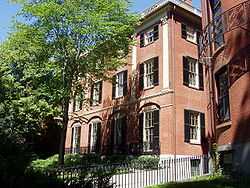Harrison Gray Otis House
There are three houses named the Harrison Gray Otis House in Boston, Massachusetts. All were built by noted American architect Charles Bulfinch for the same man, Federalist lawyer and politician Harrison Gray Otis.
First Harrison Gray Otis House
The first Otis house, built in 1796, is located at 141 Cambridge Street, next to the Old West Church in Boston's West End. It is now a National Historic Landmark, and a historic house museum owned and operated by Historic New England.
Second Harrison Gray Otis House
|
Harrison Gray Otis House, (Second) | |
|
U.S. National Historic Landmark District Contributing Property | |
 | |
|
2nd Harrison Gray Otis House, 85 Mount Vernon Street | |
 | |
| Location | Boston, Massachusetts |
|---|---|
| Coordinates | 42°21′29.89″N 71°4′3.22″W / 42.3583028°N 71.0675611°W |
| Built | 1802 |
| Architect | Bulfinch,Charles |
| Architectural style | Federal |
| Governing body | Private |
| Part of | Beacon Hill Historic District (#66000130) |
| NRHP Reference # | 73001955[1] |
| Significant dates | |
| Added to NRHP | July 27, 1973 |
| Designated NHLDCP | October 15, 1966 |
The 2nd Harrison Gray Otis House is located at 85 Mount Vernon Street. It is a fine, large, Federal-style mansion in densely developed Beacon Hill. It is listed on the National Register of Historic Places.
Here Bulfinch has made the 1st floor, with his characteristic recessed brick arches, here ornamented with Chinese fretwork balconies in iron. The facade has four bays, with somewhat odd use of Corinthian pilasters on the 2nd and 3rd floors. There is a roof balustrade and a largish, octagonal cupola. Otis lived here until 1806.
Third Harrison Gray Otis House

The 3rd Harrison Gray Otis House is located at 45 Beacon Street. Completed in 1806, it is now the home of the American Meteorological Society. This is the last and largest of the houses, also built in the Federal style, and the residence of Otis until his death in 1848. Its four stories are organized into five bays. The center entrance has a small, rectangular portico with delicate pairs of Ionic fluted columns. The modest ground floor, now faced in stone, originally had the recessed brick arches typical of Bulfinch houses. When built, the house was freestanding, surrounded by the Boston Common and English gardens.
See also
References
- ↑ "National Register Information System". National Register of Historic Places. National Park Service. 2007-01-23.
External links
| |||||||||||||||||||||||||||||||||||||||||||||||||||||||
